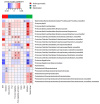Microbiome Responses to an Uncontrolled Short-Term Diet Intervention in the Frame of the Citizen Science Project
- PMID: 29738477
- PMCID: PMC5986456
- DOI: 10.3390/nu10050576
Microbiome Responses to an Uncontrolled Short-Term Diet Intervention in the Frame of the Citizen Science Project
Abstract
Personalized nutrition is of increasing interest to individuals actively monitoring their health. The relations between the duration of diet intervention and the effects on gut microbiota have yet to be elucidated. Here we examined the associations of short-term dietary changes, long-term dietary habits and lifestyle with gut microbiota. Stool samples from 248 citizen-science volunteers were collected before and after a self-reported 2-week personalized diet intervention, then analyzed using 16S rRNA sequencing. Considerable correlations between long-term dietary habits and gut community structure were detected. A higher intake of vegetables and fruits was associated with increased levels of butyrate-producing Clostridiales and higher community richness. A paired comparison of the metagenomes before and after the 2-week intervention showed that even a brief, uncontrolled intervention produced profound changes in community structure: resulting in decreased levels of Bacteroidaceae, Porphyromonadaceae and Rikenellaceae families and decreased alpha-diversity coupled with an increase of Methanobrevibacter, Bifidobacterium, Clostridium and butyrate-producing Lachnospiraceae- as well as the prevalence of a permatype (a bootstrapping-based variation of enterotype) associated with a higher diversity of diet. The response of microbiota to the intervention was dependent on the initial microbiota state. These findings pave the way for the development of an individualized diet.
Keywords: 16S rRNA metagenomics; citizen science; gut microbiota; intervention; microbiome stability; personalized diet; responders.
Conflict of interest statement
The authors declare no conflict of interest. The funding sponsors had no role in the design of the study; in the collection, analyses, or interpretation of data; in the writing of the manuscript, and in the decision to publish the results.
Figures





References
-
- Dubinkina V.B., Tyakht A.V., Odintsova V.Y., Yarygin K.S., Kovarsky B.A., Pavlenko A.V., Ischenko D.S., Popenko A.S., Alexeev D.G., Taraskina A.Y., et al. Links of gut microbiota composition with alcohol dependence syndrome and alcoholic liver disease. Microbiome. 2017;5:141. doi: 10.1186/s40168-017-0359-2. - DOI - PMC - PubMed
MeSH terms
Substances
LinkOut - more resources
Full Text Sources
Other Literature Sources

